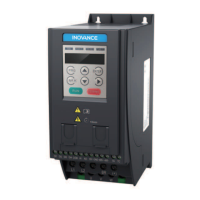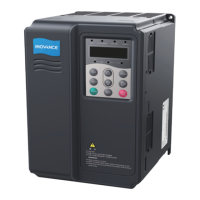Options
‑90‑
K is set to a value around 50%.
Pr indicates the power of the braking resistor.
D indicates the braking frequency, that is, percentage of the regenerative process to
the whole working process.
The following equations are obtained according to the preceding two formulas:
K x Pr = Pb x D = U x U/R x D
Pr = (U x U x D)/(R x K)
The braking resistor power Pr can be calculated accordingly.
K is the derating coefficient of the braking resistor. A small value of K prevents the
braking resistor from overheat. Increase K moderately if heat can be well dissipated,
but in no case should K exceed 50%. Failure to comply may result in braking resistor
overheat and fire.
Braking frequency (D) is determined by applications. Typical values of braking
frequency in different applications are listed in "
Table 5–37
"
on page 90
.
Table 5–37 Typical values of braking frequency in different applications
Application Elevator Winding and
unwinding
Centrifuge Occasional
braking load
General
application
Braking
Frequency
20% to
30%
20% to 30% 50% to 60% 5% 10%
Dimensions of braking units
The following figures show dimensions of two braking unit series.
Figure 5‑32 Dimensions of MDBUN series braking units (MDBUN‑45‑2T to MDBUN‑90‑2T;
MDBUN‑45‑T to MDBUN‑90‑T; MDBUN‑45‑5T to MDBUN‑90‑5T) (mm)

